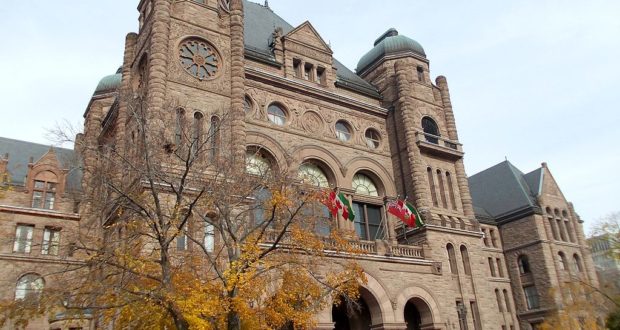This summer, the Ontario government conducted consultations regarding its plan to enact “safe access zones legislation” (SAZL) modeled on British Columbia’s.
I’ll give a brief background on B.C.’s law before diving into a division of powers argument against enacting such a law in Ontario. In short, I will argue that just as a province cannot enact a penal prohibition on abortion (Morgentaler 1993), so too it cannot enact criminal law to prohibit anti-abortion expression. It is a rule of Canadian constitutional law that provincial and municipal governments may not censure certain messages based on their content. This guards against local ideological biases. A province may also not “fill gaps” in the criminal law.
B.C.’s Access to Abortion Services Act
British Columbia’s Access to Abortion Services Act (AASA) came into force in 1996. Section 2 AASA makes it an offence, punishable by fine and imprisonment, to do the following while in an “access zone”:
(a) engage in sidewalk interference;
(b) protest;
(c) beset;
(d) physically interfere with or attempt to interfere with a service provider, a doctor who provides abortion services or a patient;
(e) intimidate or attempt to intimidate a service provider, a doctor who provides abortion services or a patient.
Important terms are defined in section 1:
“protest” includes any act of disapproval or attempted act of disapproval, with respect to issues related to abortion services, by any means, including, without limitation, graphic, verbal or written means;
“sidewalk interference” means (a) advising or persuading, or attempting to advise or persuade, a person to refrain from making use of abortion services, or (b) informing or attempting to inform a person concerning issues related to abortion services.
The law also prohibits harassment of service providers, doctors, or patients under section 4, which is not limited in its application to access zones:
4 (1) A person must not do any of the following for the purpose of dissuading another person from providing or facilitating the provision of abortion services:
(a) repeatedly approach, accompany or follow the other person, or a person known to the other person;
(b) beset;
(c) engage in threatening conduct directed at the other person or a person known to the other person.
(2) A person must not repeatedly communicate by telephone, facsimile or electronic means with another person without their consent for the purpose of dissuading a service provider or doctor who provides abortion services from beginning or continuing to provide, or to facilitate the provision of, abortion services.
The rest of the AASA is centred around and gives effect to these offences.
Ontario’s proposed law is beyond its jurisdiction to enact
The Ontario government cannot enact “safe access zones legislation” (SAZL).
The government of Ontario, or any province, cannot enact criminal law or attempt to supplement, stiffen, replace, or “fill gaps” in the criminal law. This is a basic constitutional rule.
While British Columbia’s law was upheld under challenge, the issue of the government’s jurisdiction was only addressed by a provincial court judge presiding over a self-represented litigant. The provincial court judge’s reasoning in dismissing the claim that B.C.’s Access to Abortion Services Act is beyond B.C.’s jurisdiction is very weak. Just because B.C.’s government claimed it wanted to promote “access to abortion” does not mean that health care is the “pith and substance” of the law. Rather, B.C.’s entire Access to Abortion Act centres around and gives effect to the penal provisions, which target and punish certain conduct.
Minister Naqvi cites reports of alleged harassment by a small group of protesters in his riding in Ottawa as justification for introducing SAZL. Newfoundland and Labrador’s Justice Minister, similarly, cited intimidation and harassment as the reason for that province’s new law.
The SAZL of British Columbia, Quebec, and Newfoundland and Labrador violate Canada’s constitutional division of powers by (1) attempting to supplement Canada’s criminal law, which already prohibits harassment, intimidation, assault, terrorism, mischief, and common nuisance; and, (2) prohibiting certain categories of expression defined by their content.
Ontario’s proposed law would create new criminal offences or broaden existing ones, which only Parliament can do
If there were many crimes taking place in a particular area, a province or city might try to pass laws or bylaws to suppress the conditions leading to crime. Establishments that serve alcohol might have to close at a certain time or lose their liquor license, for example. Or a city might want to promote the safe use of sidewalks, instituting fines for holding large, obstructive signs.
B.C.’s law, however, makes it an offence, punishable by major fines and imprisonment to behave in certain ways. It makes it an offence to communicate disapproval of abortion in any way, or even to inform a person concerning issues related to abortion services. The fact that these penal provisions are limited to “access zones” does not change their essential character. Their intent is to punish behaviour that the government considers a public evil, a form of harassment, intimidation, or oppression of vulnerable persons. They seek to broaden the criminal law.
Consider what the Supreme Court of Canada said in Westendorp ([1983] 1 SCR 43) about a municipal law, limited in application to public streets, that prohibited approaching another person for the purpose of prostitution:
[The bylaw] is activated only by what is said by a person […]. For persons to converse together on a street, […] and to discuss a recent or upcoming sporting event or a concert or some similar event would not attract liability. It is triggered only by an offer of sexual services or a solicitation to that end. There is no violation of section 6.1 by congregation or obstruction per se; the offence arises only by proposing or soliciting another for prostitution.
And,
If a province or municipality may translate a direct attack on prostitution into street control through reliance on public nuisance, it may do the same with respect to trafficking in drugs. And, may it not, on the same view, seek to punish assaults that take place on city streets as an aspect of street control’?
To prohibit people from communicating for the purpose of informing people about abortion is patently an attempt to punish what this government considers to be a public evil.
Ontario’s proposed law would attempt to lower the threshold for the crimes of harassment and intimidation
The provinces with SAZL have general prohibitions on “harassment”, an offence which includes repeatedly communicating with a person by phone, facsimile or electronic means for the purpose of dissuading that person from providing abortion services, among other conduct.
The provision is remarkably similar to the Criminal Code prohibition on harassment, except that it lowers the standard for conviction. To be convicted of harassment under the Criminal Code, the Crown must prove: (1) that the accused engaged in the prohibited conduct (repeated communication, approaching, besetting, etc.); (2) that the complainant was in fact harassed by the prohibited conduct, meaning he or she was “tormented, troubled, worried continually or chronically, plagued, bedevilled and badgered”; (3) that the accused knew that the complainant was harassed or was reckless or wilfully blind as to whether the complainant was harassed; (4) that the conduct caused the complainant to fear for his or her safety or the safety of anyone known to him or her; and (5) that the complainant’s fear was reasonable in the circumstances.
Under B.C.’s law, however, requirements (2) – (5) are simply absent, meaning essentially that abortion providers are given a level of protection not accorded to anyone else. The province simply cannot do this; it violates the division of powers. B.C.’s law also effectively broadens the offence of intimidation (Code, s. 423) by removing the exception permitting peaceful protest.
Ontario’s proposed law would attempt to tailor criminal offences to particular settings
Assault is assault whether you hit someone with your hand or elbow, whether you are big or small. Murder is the intentional killing of a human being, regardless of the means used. In many ways, however, the Criminal Code is tailored for certain settings. The Code prohibits conduct in certain places or contexts or towards certain people that is not prohibited in other places or contexts or towards other people, or is prohibited but subject to lesser penalties when committed in other places or contexts or in relation to other categories of people.
For example, the criminal prohibition against mischief in section 430 of the Code spells out different penalties depending on the nature of the property in relation to which mischief is committed, with special protections for religious and cultural property and war memorials. The Criminal Code prohibits obtaining sexual services for consideration or communicating with anyone for that purpose, but imposes more severe penalties where the offence is committed “in a public place, or in any place open to public view, that is or is next to a park or the grounds of a school or religious institution or that is or is next to any other place where persons under the age of 18 can reasonably be expected to be present”. So the Code is tailored for particular places.
The offence of intimidation in section 423 of the Code – which is similar in some ways to the offence of harassment – gives particular attention to journalists and justice system participants. Threatening an internationally protected person or United Nations personnel is specifically prohibited (ss. 424 and 424.1), as is attacking the premises, residence or means of transport of such persons (ss. 431 and 431.1). So the Code is tailored for certain categories of persons.
Where Parliament has not enacted extraordinary or targeted protections for certain persons, places, or activities (or categories thereof), it does not mean that provinces may do so. Provinces may not supplement, stiffen, or fill perceived gaps in the criminal law.
Canada’s Parliament has not decided that extraordinary restrictions are necessary on conduct or expression on public property near abortion facilities. Nor has Parliament decided that extraordinary protections are needed for personnel involved in providing abortion services. Abortion facilities are protected by criminal provisions generally related to protecting property. Abortion service providers and patients likewise are protected by many Criminal Code provisions prohibiting others from assaulting, threatening, harassing, or intimidating them.
Ontario’s proposed law impermissibly targets a message that this government dislikes
Notably, existing SAZL in Canada do not simply prohibit setting up signs outside of health service facilities, for example, but target only the pro-life message in any form. Under B.C.’s law, handing out pro-choice pamphlets or holding pro-choicesigns outside of abortion clinics, or pregnancy care centres for that matter, is completely legal. Imagine a more pro-life government in this or another province enacting such a law, but changing “dissuade” to “persuade”. The pro-life message happens to be the message that is disliked by this government.
Consider Quebec’s Act Respecting Communistic Propaganda of the Province of Quebec (1941), a law that targeted expression promoting communism – expression considered a threat to peace and order in that day. The law made it unlawful “to print, to publish in any manner whatsoever or to distribute in the Province any newspaper, periodical, pamphlet, circular, document or writing whatsoever propagating or tending to propagate communism or bolshevism.” The punishment was not jail, but the closure of property used for propagating communism. The Supreme Court nevertheless struck down the law as being ultra vires the province, in Switzman v Elbling, [1957] SCR 285.
Justice Nolan wrote: “Clearly [the Act] affects the use of property within the Province, but, in my view, it is not related to property and civil rights or to matters of a local or private nature in the Province, but its true nature and purpose is the suppression of communism by creating a new crime with accompanying penal provisions.” Justice Nolan also stated that “whether or not the Dominion Parliament has made communism a crime or forbidden its propagation, it has the exclusive jurisdiction to do so.” Similarly, whether or not Parliament has criminalized anti-abortion messaging, it has exclusive jurisdiction to do so.
In a concurring judgement, Justice Rand wrote: “The object of the legislation […] is admittedly to prevent the propagation of communism and bolshevism, but it could just as properly have been the suppression of any other political, economic or social doctrine or theory […].” Moreover, concern with “local conditions” cannot “extend legislation to matters which lie outside of s. 92 [of the Constitution Act, 1867].” Parliamentary democracy requires “virtually unobstructed access to and diffusion of ideas” and restricting this access is “not a matter within the Regulation of a Province,” Justice Rand said.
That only Parliament can prohibit the communication of certain messages protects against local biases. As Justice Rand explained in Switzman v Elbling: “[F]reedom discussion in Canada […] has a unity of interest and significance extending equally to every part of the Dominion. With such dimensions it is ipso facto excluded from [provincial jurisdiction] as a local matter.”
The fact that abortion is legal and Ontario funds it is irrelevant
Framing the objective of this law as “access to health care” is absurd. The province can adduce no evidence of people being unable to obtain an abortion because of anti-abortion messaging in the street. Rather, the objective is to punish some people for the offence of making other people uncomfortable. A recent Ontario Court of Appeal judgement, though addressing freedom of expression under the Charter (rather than a division of powers issue), is instructive on this point:
The application judge [erroneously] extended the concept of violence to include actions and words associated with a traditional form of political protest, on the basis that some Town employees claimed they felt ‘unsafe’. This goes much too far. A person’s subjective feelings of disquiet, unease, and even fear, are not in themselves capable of ousting expression categorically from the protection of s. 2(b). – Bracken v Fort Erie, 2017 ONCA 668, para 49.
Moreover, the fact that abortion is legal (it is not a “right” in a constitutional sense) is irrelevant. We are free to do many things, but that does not mean that the province has authority to punish interference with the enjoyment of people’s rights or freedoms. Notably, section 423 of the Criminal Code already prohibits intimidating conduct “for the purpose of compelling another person to abstain from doing anything that he or she has a lawful right to do”.
Finally, the fact that the provincial government funds abortion services is also irrelevant. The provincial government also funds education, but that does not mean that it can create new penal offences for harassing or intimidating teachers or school administrators.
The alleged problems can be addressed by ordinary police powers and existing law
Minister Naqvi says laws like this are more important than ever in an increasingly polarized society. If anything, he is fanning the flames of polarization for political gain. He is sending a message that peaceful protest is intolerable. There is no reason for this proposed law. The Criminal Code already prohibits mischief, assault, harassment, intimidation, and nuisance.
Consider the words of Supreme Court Chief Justice Laskin in Dupond: “There is no accretion to provincial legislative authority to enable it to deal with apprehended danger merely because the provincial government or delegated municipal authorities are of the opinion that preventive measures must be taken. These may be taken under ordinary police powers and in accordance with the Criminal Code” (Canada (AG) v. Montreal (City), [1978] 2 S.C.R. 770). While a majority of the Supreme Court in that case upheld a bylaw prohibiting the holding of an assembly or parade in Montreal for 30 days, it is noteworthy that this bylaw only allowed for temporary prohibitions of general application, and breach was not punishable by prison time.
This is a job for the Minister of Community Safety and Correctional Services, Marie-France Lalonde. She can work with the police to make sure they are policing effectively. There are allegations that someone approaching the Morgentaler Clinic in Ottawa was spat on. That is assault. The alleged offender should be prosecuted. But other people should not be imprisoned for attempting to inform people about abortion near an abortion clinic or anywhere else.
This essay was originally prepared for ARPA Canada’s response to the Ontario government’s consultations on the question of introducing “safe access zones legislation”.
 Advocates for the Rule of Law
Advocates for the Rule of Law



